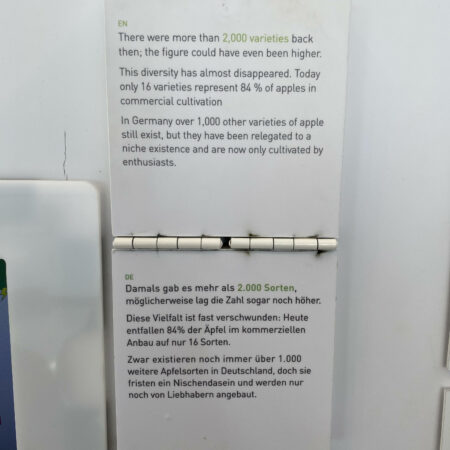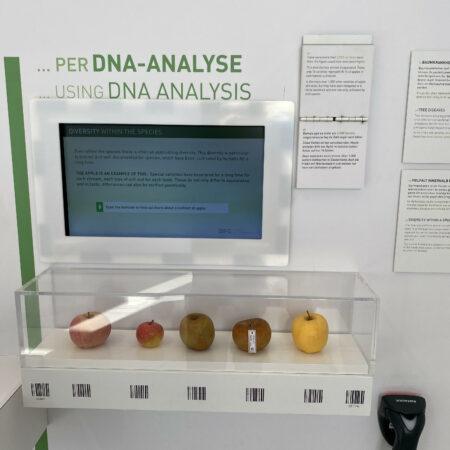- IFAD says we need diverse crops.
- KAUST says we need coloured rice.
- I hope it will go into Saudi Arabia’s new genebank.
- Genebank scientists says we need more collaboration.
- Goa thinks they need a new mango genebank.
- The USA already has an apple genebank.
- But will all these genebanks lead to a new Green Revolution…
- …or organic farming?
- Maybe both.
An apple a day…
Good question. The answer?
It’s all part of a very nice exhibit at the Museum Koenig in Bonn on biodiversity research.
Great to see agricultural research get a look-in.
But pity there was nothing on genebanks, and indeed no call to action. There’s a whole website in Germany about “edible landscapes” that offers ideas about what to do to help preserve fruit diversity. And also shops in and around Bonn that boast about selling lots of apple varieties, including less well known one.
Branfood: Salinity tolerance, Comestibles, Underused species, On farm diversity, Minor cereals, Fragrant millet, Wild yams, Fonio, Winged bean, Giant taro, Nutmeg, Mungbean, Finger millet, Amaranth
- Salt-Tolerant Crops: Time to Deliver. Sure, breeding for salt tolerance using crop wild relatives is great, but have you tried just domesticating salt-tolerant wild species?
- Wild and cultivated comestible plant species in the Gulf of Mexico: phylogenetic patterns and convergence of type of use. No word on how many are salt-tolerant.
- Underutilized plants increase biodiversity, improve food and nutrition security, reduce malnutrition, and enhance human health and well-being. Let’s put them back on the plate! No word on how many are salt-tolerant.
- Indigenous crop diversity maintained despite the introduction of major global crops in an African centre of agrobiodiversity. If you want local crop diversity in Highland Ethiopia, look for it on the farms of the poorest. No word on how many are “underutilized”.
- The role of minor cereals in food and nutrition security in Bangladesh: constraints to sustainable production. Low yields, apparently. I think it could do with having aromatic grains. If only there was a way to make that happen…
- De novo creation of popcorn-like fragrant foxtail millet. Yeah, sometimes neither the crop not its wild relatives has the genes for it. Still, if you can edit in aroma, why not salt-tolerance?
- Global Genepool Conservation and Use Strategy for Dioscorea (Yam). I wonder how many of these 27 wild species could usefully be domesticated. Or are salt-tolerant.
- Towards conservation and sustainable use of an indigenous crop: A large partnership network enabled the genetic diversity assessment of 1539 fonio (Digitaria exilis) accessions. This is how you start to undo underutilization. I’m sure someone will edit it next.
- Diversity Assessment of Winged Bean [Psophocarpus tetragonolobus (L.) DC.] Accessions from IITA Genebank. Same as above, but with one hundredth as many accessions. I guess winged bean is even more underutilized than fonio.
- The forgotten giant of the Pacific: a review on giant taro (Alocasia macrorrhizos (L.) G.Don). Sad to say it doesn’t seem to be salt-tolerant. Maybe it’s aromatic, though. Or could be gene-edited to become so. Wouldn’t that be something.
- Retracing the center of origin and evolutionary history of nutmeg Myristica fragrans, an emblematic spice tree species. No need for editing, let’s just conserve the really diverse populations of the North Moluccas.
- Demographic history and distinct selection signatures of two domestication genes in mungbean. Domesticating the mungbean wasn’t all that easy. Hope it’s easier for some random salt-tolerant wild species.
- A plausible screening approach for moisture stress tolerance in finger millet (Eleusine coracana L.) germplasm accessions using membership function value at the seedling stage. Will it work on fonio? Or salt-tolerance?
- Adoption and impact of improved amaranth cultivars in Tanzania using DNA fingerprinting. So can we stop calling it underutilized? And start gene-editing it for aroma?
Nibbles: China seeds, Dixie apples, USDA genebanks, ASU dates, IPR, IFG grapes, Pick-a-mix, Coffee ESG, French heirlooms, Belgian brewing, Tanzanian sorghum, Horse-bread, Roots & tubers, Guyana cassava, SDG indicators
- China announces a slew of seed-related measures.
- A slew of seeds kept apples diverse in the US South, but not so much any more.
- Fortunately there’s a slew of apples, among many other things, in the USDA genebank system.
- Dates too, probably, but this article is actually about the (complementary?) collection at Arizona State University.
- A slew of intellectual protections has been good for seed companies. But consumers?
- IFG no doubts benefits mightily from intellectual property protection of its grape varieties. The diversity of which you can peruse on this nice website.
- Speaking of nice websites, this one helps farmers pick-a-mix of crops. Intercropping is diversity too.
- How the coffee industry is trying to cope with a slew of sustainability rules. Yeah, sometimes IP protection is not enough.
- But who owns heritage varieties?
- Including heritage varieties of Belgian malting barley and other cereals.
- Speaking of malting, they use sorghum in Tanzania.
- It’s unclear what heritage varieties went into making horse-bread, but I’d like to taste the stuff.
- But who needs bread (or beer?) anyway? There’s a slew of root and tuber crops in Africa and elsewhere just waiting to solve hunger…
- …as Guyana knows well.
- Wanna keep track of (most of) the above? FAO has you (sorta) covered via a slew of indicators.
Brainfood: Food security, Genebank risks, Climate-smartness, Improved veggies, Tree database, Potato disease, Seed system resilience treble, Community seedbanks, Varietal replacement, Kenyan maize diversity
- Diversifying agrifood systems to ensure global food security following the Russia–Ukraine crisis. Diversify markets, production, crops and technology to de-risk agrifood systems.
- Genebanks at Risk: Hazard Assessment and Risk Management of National and International Genebanks. De-risk genebanks first though.
- Climate-Smart Agriculture in African Countries: A Review of Strategies and Impacts on Smallholder Farmers. Could have made more of the need for diversity, but improved varieties at least are in there.
- Adoption and impact of improved amaranth cultivars in Tanzania using DNA fingerprinting. Yeah, even improved varieties of traditional local veggies, why not.
- GlobalUsefulNativeTrees, a database documenting 14,014 tree species, supports synergies between biodiversity recovery and local livelihoods in landscape restoration. But don’t forget trees.
- Efforts of researchers and other stakeholders to manage an unfolding epidemic: Lessons from potato purple top in Ecuador. Resilience is hard.
- Seed Systems Resilience—An Overview. Continuous flow of diversity, trustworthy institutions and innovation are needed to de-risk seed systems. Would certainly have helped with the above.
- Navigating toward resilient and inclusive seed systems. Or…: do no harm, think diversity and adopt a seed security perspective. Good to see diversity as the common thread in this discourse.
- Seed systems development to navigate multiple expectations in Ethiopia, Malawi and Tanzania. The above put into practice.
- Community seed banks: Instruments for food security or unsustainable endeavour? A case study of Mkombezi Community Seed Bank in Malawi. Yes, indeed, community seedbanks can contribute to seed systems resilience and food security.
- Maize varietal replacement in Eastern and Southern Africa: Bottlenecks, drivers and strategies for improvement. Seed companies need to be more proactive…
- Why farmers use so many different maize varieties in West Kenya? …but remember about doing no harm. And we’re back to diversity I see.



